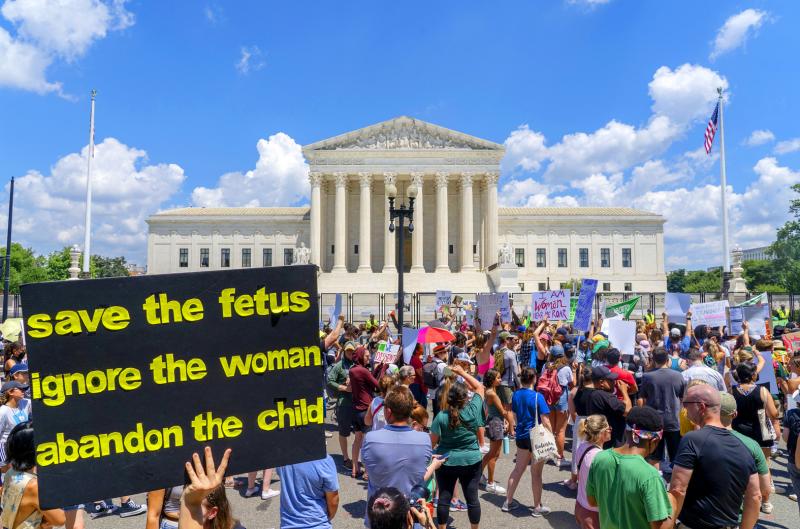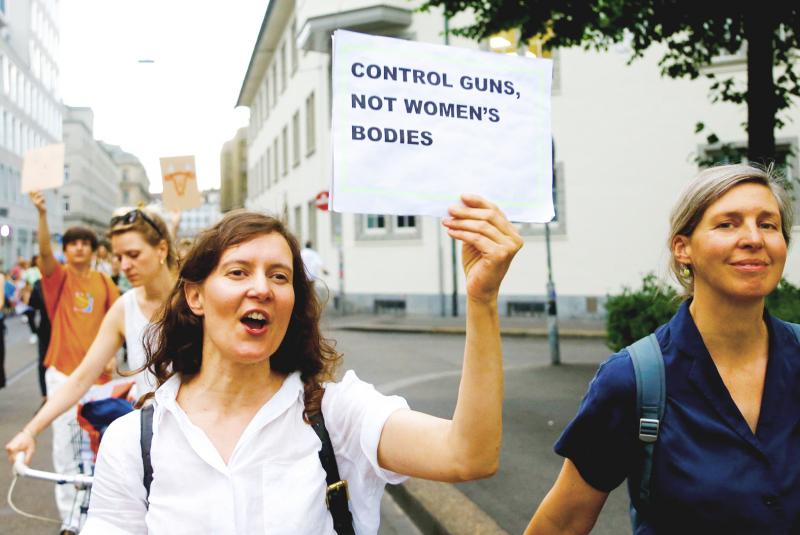The US Supreme Court has ruled there is no constitutional right to abortion in the US, upending the landmark Roe v Wade case from nearly 50 years ago in a rare reversal of long-settled law that will fracture reproductive rights in America.
Since the US Supreme Court’s Roe v. Wade decision legalized abortion nationwide in 1973, the issue has become one of the defining fault lines in US politics, with Democratic politicians firmly supporting abortion rights and Republican lawmakers lining up in opposition.
In 1973 the lines were more blurred. Republican and Democratic voters were equally likely to say abortion should be legal, while it was easy to find Republican officials who supported abortion rights and Democrats who opposed the procedure.

Photo: AP 照片:美聯社
So what changed?
NOT A PARTISAN ISSUE AT FIRST
Abortion on demand was legal in four states in the early 1970s, while 14 more allowed it under some circumstances.

Photo: Reuters 照片:路透
While the Catholic Church opposed abortion, the Southern Baptist Convention, the largest evangelical denomination, was on record saying it should be allowed in many circumstances.
Neither party viewed abortion as a defining issue.
Voters also did not see the issue along partisan lines. The General Social Survey opinion poll found in 1977 that 39 percent of Republicans said abortion should be allowed for any reason, compared to 35 percent of Democrats.
A CONSERVATIVE MOVEMENT MOBILIZES
In the years that followed, conservative activists like Phyllis Schlafly seized on the issue as a threat to traditional values and enlisted evangelical churches, which had shown a new interest in politics following a series of court rulings that limited prayer in public settings.
These groups portrayed abortion as a threat to the family structure, along with broader social developments like gay rights, rising divorce rates, and women working outside of the home. For pastors and parishioners, abortion became a proxy issue for concerns about a liberalizing society, said Mary Ziegler, a legal historian at University of California-Davis.
“For many evangelicals, this was more about family and women and sex,” she said.
In 1980, the Southern Baptist Convention passed a resolution opposing abortion, reversing its earlier position.
POLITICIANS PICK SIDES - VOTERS FOLLOW
In the years that followed, the dividing lines became more apparent as political candidates found it increasingly necessary to align with activists who were becoming more influential within their parties.
Since 1989, abortion-rights groups have donated US$32 million to Democrats and US$3 million to Republican candidates who support keeping abortion legal, according to OpenSecrets, which tracks money in politics. Groups that opposed abortion have given US$14 million to Republicans and only US$372,000 to Democrats over that time period.
Partisan differences widened in the following years, however, as the issue became a staple of TV attack ads fundraising appeals and mass rallies by interest groups.
Other opinion polls have consistently shown that most Americans support some restrictions on abortion but oppose an outright ban.
At the same time, Democrats have grown more absolute in their support for abortion rights.
(Reuters and The Guardian)
美國最高法院裁定,墮胎權不受美國憲法保障,推翻了近五十年前具里程碑意義的「羅訴韋德案」,這逆轉制定已久法律的罕見之舉,將破壞美國的生殖權利。
自一九七三年美國最高法院對羅訴韋德案的裁決將墮胎在全美合法化以來,墮胎議題已成為美國政治的決定性斷層線之一,民主黨政客堅定支持墮胎權,而共和黨議員則是加入反對的行列。
在一九七三年,這條分界線是模糊得多的。共和黨及民主黨的選民同樣可能認為墮胎應該合法,也很容易找到支持墮胎權的共和黨官員以及反對墮胎手術的民主黨人。
那麼是發生了什麼變化?
起初非關黨派
一九七○年代初期,應要求而墮胎在四個州是合法的,且還有十四州允許在某些情況下墮胎。
雖然天主教會反對墮胎,但最大的福音教派美南浸信會卻公開表示,墮胎在許多情況下都應被允許。
兩黨皆未將墮胎視為決定性的問題。
選民也沒有把此議題看做是黨派路線。一九七七年的美國社會概況調查發現,百分之三十九的共和黨員認為出於任何原因的墮胎皆應被允許,民主黨員持此觀點的比例為百分之三十五。
保守陣營動員起來
在隨後的幾年裡,像菲利斯‧斯拉夫萊這樣的保守派活動家抓住此議題,將之視為對傳統價值觀的威脅,並串聯了福音派教會,這些教會在法院一連串裁決限制在公共場合禱告後,對政治顯出新的興趣。
這些團體將墮胎與同性戀權利、離婚率上升、女性外出工作等更廣泛的社會發展,描述為對家庭結構的威脅。加州大學戴維斯分校法律史學家瑪麗‧齊格勒表示,對於牧師和教區居民來說,墮胎成為一個代罪問題,概括了對社會日益自由化的擔憂。
「對於許多福音派人士來說,它實為攸關家庭、女性和性的問題」,她說。
一九八○年,美南浸信會通過了一項決議,反對墮胎,一反先前之立場。
政治選邊站 選民隨之起舞
在隨後幾年,政治候選人愈發覺得有必要跟在黨內影響力日漸增大的活動家口徑一致,此分界線也隨之變得更加明顯。
根據追蹤政治獻金的組織OpenSecrets的資料,自一九八九年以來,墮胎權利組織已捐贈民主黨三千兩百萬美元,向支持墮胎維持合法的共和黨候選人捐獻了三百萬美元。與此同時,反墮胎團體捐獻了一千四百萬美元給共和黨,而捐給民主黨的金額僅有三十七萬兩千美元。
然而,之後幾年墮胎議題成為電視廣告攻擊、募款與利益團體大型集會的主題,黨派分歧也隨之擴大。
其他民調皆顯示,大多數美國人支持對墮胎採取一些限制,但反對徹底禁止。
與此同時,民主黨員對墮胎權的支持變得更加絕對。
(台北時報林俐凱編譯)

A Cameroon-flagged cargo vessel “Shunxin-39” was believed to have caused damage to an undersea cable of Taiwan telecoms operator Chunghwa Telecom on the morning of Jan. 3. It was suspected that the Chinese merchant ship, which was registered with the nationality of another country, deliberately cut off the cable by dragging the anchor over it. While the incident is still under investigation, China has a long history of using maritime tactics to sabotage Taiwan’s infrastructure. In February last year, two cables linking Taiwan to its outlying Matsu Islands were damaged within days of each other by a Chinese fishing

Have you ever dreamed of using an entire city as your training ground, effortlessly moving across walls, buildings, stairs, and obstacles? This is not just a fantasy from the movies. In cities around the world, a group of enthusiasts practice this seemingly impossible sport — “parkour.” The origins of parkour can be traced back to 20th-century France. A military officer named Georges-Hebert witnessed the incredible physical abilities of local residents in Africa, which inspired him to create the Methode Naturelle, or natural method. This training method cleverly combined climbing, running, and swimming with artificial barriers to mimic nature. Later, David Belle

A: The 21st Century is now entering its 25th year. B: So Billboard has released a list: “The 25 greatest pop stars of the 21st Century.” A: Who are the greatest pop singers? B: No. 25 to 16 are: Katy Perry, Ed Sheeran, Bad Bunny, One Direction, Lil Wayne, Bruno Mars, BTS, The Weeknd, Shakira and Jay-Z. A: Wow, my favorite K-pop supergroup BTS has made it to the list. A: 21世紀正在邁入第25個年頭了。 B: 《告示牌》雜誌特別公布:「21世紀最偉大的25位流行歌手」。 A: 最偉大的歌手有哪些? B: 第25至16名是:凱蒂佩芮、紅髮艾德、壞痞兔、1世代、小韋恩、火星人布魯諾、防彈少年團(BTS)、威肯、夏奇拉、Jay-Z。 A: 哇,我最愛的韓流天團BTS也上榜了! (By Eddy Chang, Taipei Times/台北時報張聖恩)

A: Who else is on Billboard’s list: “The 25 greatest pop stars of the 21st Century?” B: No. 15 to 6 are: Miley Cyrus, Justin Timberlake, Nicki Minaj, Eminem, Usher, Adele, Ariana Grande, Justin Bieber, Kanye West and Britney Spears. A: I can’t believe that Adele’s only at No. 10. B: No. 5 to 1 are: Lady Gaga, Drake, Rihanna, Taylor Swift and Beyonce. A: Well, they surely deserve the honor. A: 《告示牌》雜誌的「21世紀最偉大的25位流行歌手」,還有誰上榜啊? B: 第15至6名是:麥莉希拉、大賈斯汀、妮姬米娜、阿姆、亞瑟小子、愛黛兒、亞莉安娜、小賈斯汀、肯伊威斯特、小甜甜布蘭妮。 A: 真不敢相信愛黛兒只排第10名。 B: 第5至1名是:女神卡卡、德瑞克、蕾哈娜、泰勒絲、碧昂絲。 A: 這幾位真是實至名歸! (By Eddy Chang, Taipei Times/台北時報張聖恩)